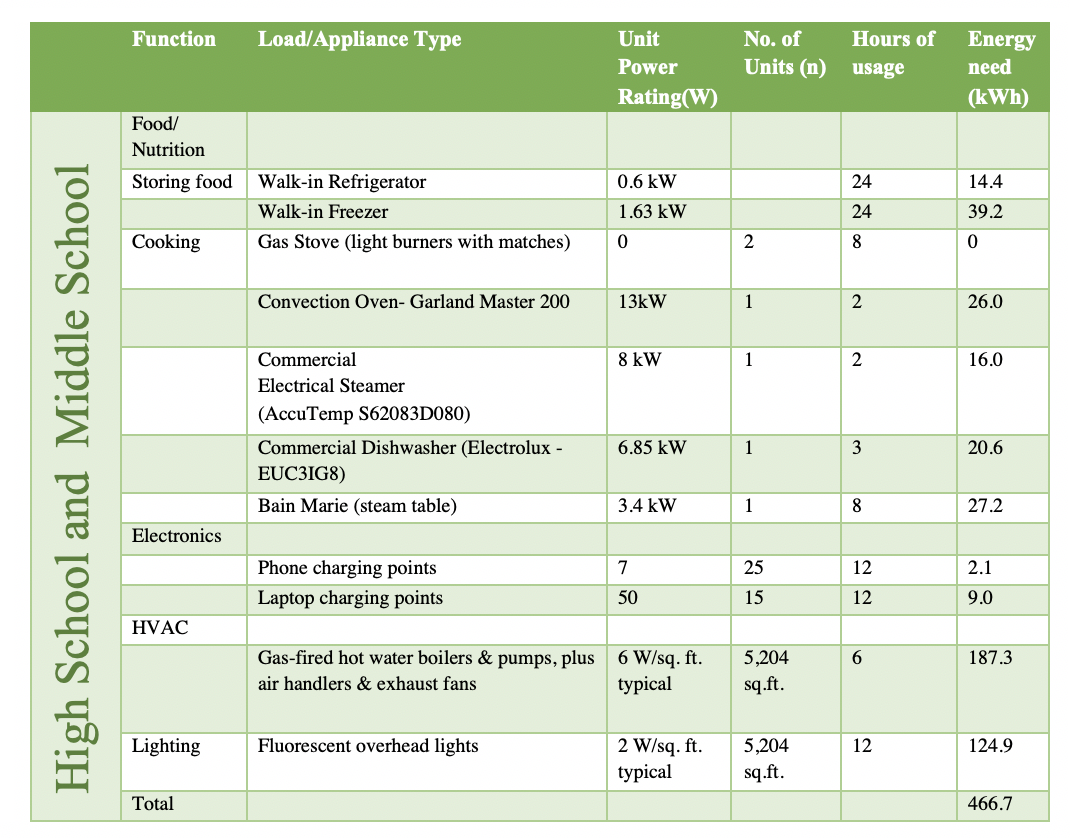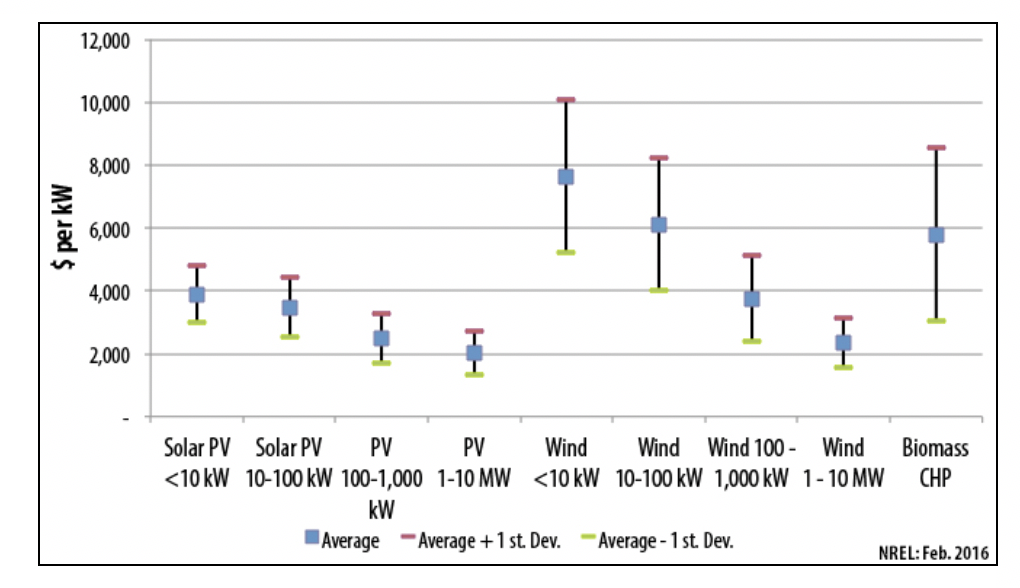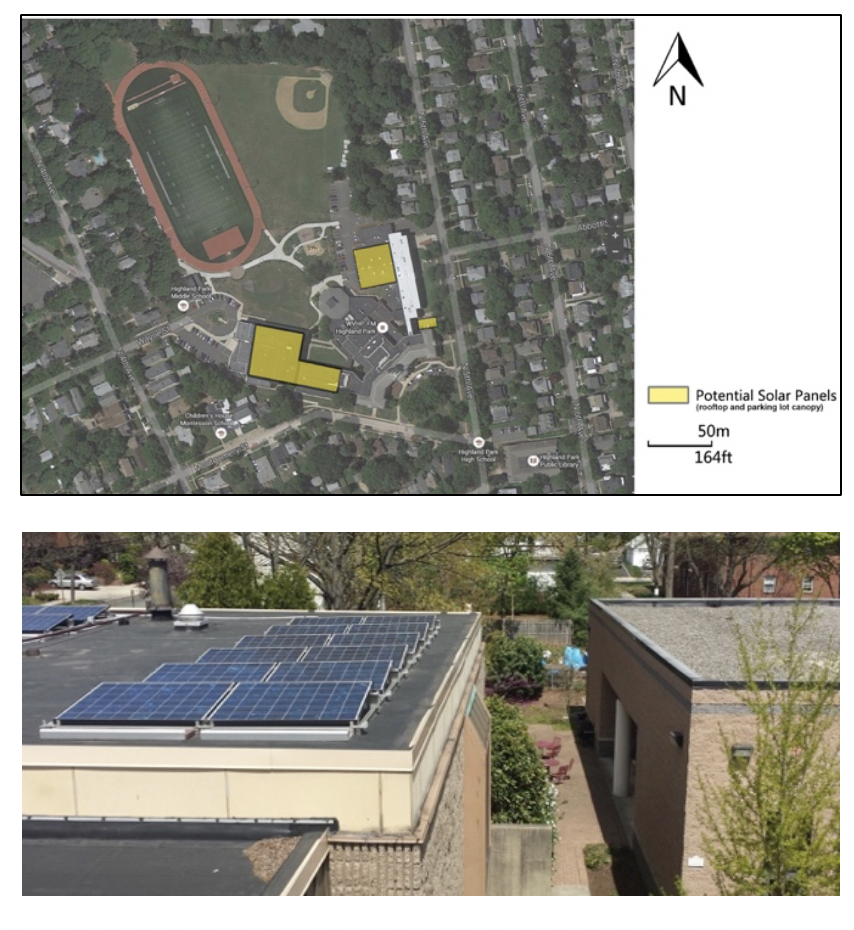Highland Park High School and Middle School Solar Islanding Study
Highland Park, NJThe Highland Park High School and Middle School was one of three potentials sites for community shelters studied as part of the Highland Park Solar Islanding Project (2015). The site fulfills at least some of the desirable traits of an emergency shelter and provides examples of community resiliency planning at the building level.
Why is it important?
Superstorm Sandy affected Highland Park and many other places following its landfall in October 2012. Among the most severe impacts for Highland Park residents were electric power outages lasting up to two weeks for portions of the municipality. This experience highlighted a need to better prepare for similar situations in the future.
A set of adequately equipped community gathering spaces can support essential functions for community residents whose homes have lost power or are otherwise uninhabitable. Sheltered spaces are needed so that residents can rest comfortably, charge their phones, and have access to basic heating and cooking facilities enabled by resilient sources of electric power.
Solar arrays outfitted with battery storage and islanding inverters can provide emergency “power islands” during times of storm or other grid outages. When implemented in community meeting places that can function independently of the grid, solar islanding increases community resiliency. In the Highland Park High School/Middle School case study, the existing solar arrays if converted to solar power islands would be able ‘to provide only modest emergency’ power.
Available energy also depends on season and system engineering specifications. Thus, a critical step in planning for solar islanding capabilities is to analyze power demands and associated functions that benefit from solar islanding.
Figure 1: High School / Middle School Site
For Whom is This Useful?
Because solar islanding has the potential to improve community resiliency, the following case study is most useful to municipalities and institutional building owners motivated to prepare community spaces for future power outages. Such institutional buildings might include schools and community shelters.
Summary of Location and Resiliency Characteristics: High School/Middle School
The Highland Park High School/Middle School (HPHSMS) campus currently does not have a solar array. Building roof and parking lot canopy structures are possible options, but it would likely be hard to construct more than 100 kW at this site, without comprising existing functions such as ball fields. Some of the kitchen equipment at the site is very electricity intensive, while HVAC requirements and lighting consumption are also considerable. A complementary strategy would be to install a solar array and battery storage system to provide backup power more sustainably.
School cafeterias serve as a potential emergency gathering place. The Highland Park High School has a safe occupancy of 372 with an attached full-featured kitchen with natural gas-fired stoves and ovens, electric dishwashers, convection ovens, and mixers. The gymnasium, nearby, also could be called into emergency service. The Middle School is smaller with a maximum capacity of 136 people with mostly electric reheating and serving facilities. As these are connected buildings, spaces and resources are flexible assets.
The HPMHMS campus could support the following critical demand-side functions:
- Phones / laptop charging
- Wi-Fi communication (depending on provider operations)
- Water heating
- Basic cooking
- Food storage
- Operation of restroom facilities
Electricity Demand Calculation
Three questions were posed in the Highland Park Solar Island Project to determine critical electrical loads:
- Must it be continuously available?
- Are there affordable and convenient substitutes?
- What are the consequences for human health and economic costs?
The following electricity demand calculations are for the high school cafeteria, assuming occupancy of 250 people for a 12-hour window.

Table 1: Electricity Demand Calculation for High School Cafeteria – hosting 250 people for a 12- hour window.
The numbers in Table 1 illustrate four important points that help to address the questions above concerning critical electrical loads. First, the heating, ventilating and air-conditioning energy requirements are very large. During an emergency, it may not be possible to operate these systems. Second, lighting is a big energy consumer if operated at normal illumination levels all day long. It may be necessary to keep most lights off and rely on daylighting through the windows wherever possible. Third, some of the kitchen equipment is very electricity intensive. It may be necessary to limit kitchen activities to the refrigerator, freezer, and gas-fired cooktops. Finally, charging cellphones and laptops is less of a concern because these devices do not consume much electrical energy. However, the ability to communicate to family members and loved ones during an emergency situation is important in supporting psychological well-being.
Cost Projections
A resilient system solution to enable sheltering capabilities at the HPHSMS would combine substantial solar photovoltaic generation with reasonably sized battery storage on site, both of which are sizeable investments.
Grid-tied solar arrays have a long history, and the costs have been coming down gradually with time, as competitive market factors have had their effect. Figure 2 shows data on costs for different kinds of renewable generation sources. The most relevant match to the systems Highland Park might consider would be the “PV 100-1,000” data point, which translates to about $3.5 to $4 per Watt, installed. This price includes the inverter, fixtures, and wiring. Parking structure arrays are probably a somewhat higher cost as they involve very sturdy designs intended to withstand very high winds. These systems might be $5/W or more, depending on the configuration.
Battery systems installed to provide resilient power backup have less track record. Also, retrofit projects added onto existing solar require an upgrade to the existing power inverter for the system. Newer inverters can provide the islanding capability not designed into the earlier New Jersey installations.

Figure 2 – Solar array installed costs for different system sizes (Source: NREL Energy Analysis. 2016)
Funding Opportunities
New Jersey is committed to a renewable energy future, and incentives for renewable energy development often are available. For the most up-to-date information on renewable energy policy and incentive structures, visit the NJ Board of Public Utilities website.
Resources
Highland Park Solar Islanding Project (2015). Prepared for the Borough of Highland Park, NJ by Jennifer Senick, Executive Director, Rutgers Center for Green Building; Dunbar Birnie, Professor of Ceramic Engineering, Department of Materials Science and Engineering; Aman Trehan, Research Graduate Assistant; Nan Chen, Research Graduate Assistant; Deborah Plotnik, Program Coordinator, Rutgers Center for Green Building, Rutgers – The State University of New Jersey.
Related Strategies
- Combined Heat and Power (CHP)
- Demand Response and Peak Load Management
- Emergency Water Supply and Storage
- Energy Star Equipment and Plug Loads
- On-site Renewable Energy Systems
- Roof Replacements and Upgrades
- Smart Metering
- Solar Islanding and Micro-Grid Ready Solar PV
- Storm Preparation and Emergency Planning
- Thermal Energy Storage

